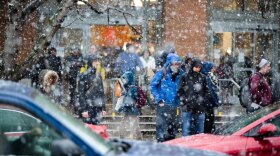In the heart of the Pacific Northwest, where the misty mountains cast shadows over lush landscapes, Indigenous activist and educator Rachel Heaton has long felt a profound connection to the majestic Tahoma. The mountain, the tallest in Washington State, has been her foundation for a captivating narrative of personal growth, environmental activism, and an unwavering quest to reclaim Indigenous spaces.
Heaton’s journey shifted in 2017, a pivotal year marked by the closure of the camp at Standing Rock, where she spent many days protesting a pipeline on Indigenous land that has since leaked several times. The aftermath of the fossil fuel divestment movement left an indelible mark on Heaton, leading her to cofound the organization Mazaska Talks (Money Talks), which works to convince large banks to divest from fossil fuels, to convince customers to divest from the banks that refuse, and, ultimately, to convince the City of Seattle to divest from Wells Fargo.
After returning to Seattle from Standing Rock, Heaton, a Muckleshoot tribal member, observed a shift in the community landscape, as challenges like drug addiction and mental health became increasingly prevalent. It was during this tumultuous time that she learned she was pregnant, a revelation that triggered a period of introspection and led her to navigate the emotional terrain of motherhood, drawing strength from her history of bodybuilding and gym ownership.
As a new mother, Heaton pondered ways to incorporate movement into her life, which led to a realization: “I’ll take gym movements based on functional foundations, and my baby will be my resistance. Hiking will be my cardio.” This revelation marked the genesis of a unique approach to fitness, using her son as resistance during hikes. The initial focus was on personal well-being, with Heaton’s mindset geared toward feeling good mentally and physically.

Heaton’s initiative expanded beyond personal fitness as she began organizing hikes for others. “Our hikes were getting longer, and in more elevation,” she recounted. “Then I thought, I’m ready to venture to the mountain.” But as the elevation she attained increased, she also noticed a lack of Indigenous people. This venture into the mountains was not merely a physical challenge but also an understanding of the absence of Native people. “We’ve been pushed out of these spaces,” Heaton lamented, expressing the need to reclaim them.
In 2021, she shared her ambitious goal with her partner: “I think I’m going to summit Mount Rainier.”
Higher and Higher
Mount Rainier, also known as Tahoma, is a prominent and active stratovolcano in the Pacific Northwest, standing at 14,410 feet. Despite its scenic beauty, the mountain is considered one of the world’s most dangerous volcanoes due to the high probability of eruption, posing a threat to the Puyallup River valley.
The Indigenous peoples around Mount Rainier have various names for the mountain in their languages. Lushootseed speakers use names like xʷaq̓ʷ and təqʷubəʔ, with the latter meaning “snow-covered mountain.” Sahaptin speakers call it Taxúma, and the Puyallup tribe, among others, call it Tahoma.
The mountain’s name has a complex history, with British Royal Navy Officer George Vancouver originally naming it after Rear Adm. Peter Rainier. Over time, different names, like “Tacoma,” were proposed, but in 1890, the U.S. Board on Geographic Names officially declared it as Rainier. The debate over its name resurfaced in 2015, echoing the discussions surrounding the restoration of the original name of the country’s highest peak, Denali, in Alaska.
In her lead-up to scaling Tahoma, Heaton meticulously researched climbing companies. Her criteria extended beyond technical expertise; she examined their language, seeking acknowledgment on their sites of Indigenous connections to the natural world.
Her journey became a powerful narrative, intertwining personal goals with environmental activism and a commitment to reintroducing Native people to spaces that had historically excluded them. Alpine Ascents, based in Seattle and with 37 years of experience leading climbs on peaks around the world, emerged as the chosen partner for her mountaineering journey, due to its commitment to honoring the mountain’s ancestral name and actively including Black, Indigenous, and People of Color (BIPOC) communities in mountaineering spaces.
Despite the challenges posed by limited knowledge and resources, Heaton forged ahead with her preparations for the climb. She highlighted her initial struggles, saying, “I had no resources, I had no one to talk to. I didn’t know anyone, and I didn’t know how to dress for the mountain.” Resolute in her determination to be on the mountain, she turned to Alpine Ascents’ resources, leveraging its website for training guidelines and required gear.

Drawing parallels between her background as a former bodybuilder and the demands of mountaineering, she humorously likened the transition: “Think of a powerlifter and a cross-country runner, and have them switch.”
Her first attempt at summiting Tahoma led her to face challenging conditions, as she carried a heavy pack with traditional foods through deep snow. Adverse weather ultimately forced her to make a difficult decision and cut the trip short. Despite the disappointment of not summiting, she emphasized the importance of safety in mountaineering, acknowledging the need for the capability to carry oneself in and out.
Undeterred by the setback, Heaton approached Alpine Ascents with her goals and aspirations. In a meeting with Gordon Janow, one of its owners, she found support and understanding. Recounting the experience, she shared, “I remember he was just super open and friendly, like, ‘Hey, what are you trying to do?’” Alpine Ascents, true to its commitment to inclusivity, collaborated to provide Heaton with another climbing opportunity.
Her subsequent climbs presented their own set of frustrations and setbacks, highlighting the unpredictable nature of the mountain. “But this time, it wasn’t because of me. It was because of the mountain: She determines if you get to make it to that summit.” Through her journey, she not only embraced the physical challenges of mountaineering but also carried the cultural significance of her Muckleshoot heritage, aiming to reintroduce traditional foods and stories to these remote spaces by sharing them with her fellow climbers. Despite not reaching the summit, she’s still determined to do so — but only when the mountain is ready for her. She hopes to make another attempt later in 2024.
A key member of the Alpine Ascents team, Jonathon Spitzer, shared valuable insights about the company’s association with Heaton and highlighted their collaboration. This collaboration aimed to establish connections with local tribes, fostering a deeper understanding of Native lands.
Reflecting on the significance of Heaton’s trainings, Spitzer emphasized their transformative nature. “The first training I did with Rachel really helped bring a better sense of the history of Tahoma, the sense of how the land has been used, a sense of the culture, and a sense of the deeper history of the mountain. And it was just really empowering.” This empowerment was particularly profound for Spitzer, who has climbed Tahoma nearly 200 times over 25 years of professional climbing.
Motivated by Heaton’s journey, Alpine Ascents is actively expanding its collaboration with Indigenous communities, extending beyond Mount Rainier to Mount Baker. In the realm of education and community outreach, initiatives with schools and younger generations aim to inspire engagement in mountaineering.
Notably, this year marks the 125th anniversary of Mount Rainier National Park, and Alpine Ascents is organizing a nonprofit fundraising climb with Heaton and tribal members to raise awareness of the region’s history and tribal lands. The company’s commitment to cultural awareness extends to language updates on its website and landing documents.
Spitzer expressed Alpine Ascents’ dedication to being at the forefront of this positive shift in the U.S. He notes that while the country has been slightly behind other places in this regard, Alpine Ascents is committed to embracing and promoting cultural understanding and responsible outdoor exploration.
Elevating Indigenous Culture
Heaton’s transformative journey to climb Tahoma with other Indigenous hikers, shared in an October 2023 REI blog post, caught the attention of Washington’s National Park Fund, igniting a significant partnership. This connection evolved into a collaboration where the fund pledged to finance the climb, covering the costs for eight climbers.

Michael Beetham, a local brands engagement specialist at REI, has worked to build community partnerships and sponsor events and organizations in the greater Seattle region. REI’s nonprofit arm, the Cooperative Action Fund, supports organizations serving Indigenous people, such as the Ancestral Lands Conservation Corps, the Center for Native American Youth, and the Indigenous Wellness Research Institute. While considering sponsorship opportunities with Washington’s National Park Fund, Beetham met Heaton.
“Through that, we found out about all the Native climbs that were happening last year,” Beetham said. The initial contact led to a conversation with Heaton, where they delved into the details of the climb and her goals. This interaction laid the foundation for REI’s involvement with Heaton.
Beetham emphasized REI’s belief in the fundamental connection between time spent outdoors and overall well-being. “We want to make sure that all people are connected to the outdoors,” he said. The unique aspects of Heaton’s climb, such as teaching about Indigenous flora, spiritual significance, and historical storytelling, resonated with REI, which supported her climb through monetary sponsorship. Additionally, REI provided gear, including backpacks, sleeping bags, and apparel for the climbing team. The company also amplified Heaton’s story through various media channels, including a podcast and a write-up.
Regarding future support for Indigenous climbers on Tahoma, Beetham expressed REI’s intent to continue its involvement with Heaton. He mentioned her plans for another climb and affirmed REI’s commitment to supporting it in a meaningful way. While the specifics were not hashed out, the intention to contribute to her future endeavors on the mountain was clear.
In the tapestry of Heaton’s journey, the threads of personal growth, environmental consciousness, and cultural revival intertwine to weave a story that transcends the summit of a mountain. She wants to reclaim spaces for her people. “It’s not just [that] I’m trying to summit a mountain. I’m trying to get our people back out there.” Viewing her work as activism, she emphasized, “We have to be in those spaces to do that.” The mountain becomes a symbol of visibility, enabling Indigenous stories to be heard and fostering cultural sustainability amid the challenges of climate change.
Reflecting on the spiritual experience atop the mountain, Heaton shared a poignant insight: “I always say, I feel like I’m close to the Creator when I’m in that space, because you’re above the clouds.” This profound connection to nature provides a respite. “The world’s problems are the world’s problems, and they’re still there. But when you’re on the mountain, there’s nothing you can do.”

Heaton actively engages in knowledge sharing and advocates for a mindset shift in mountaineering. She believes when you think about conquering a mountain, “you’re missing the journey of connecting to the water and the land and the importance of those glaciers and the communities that they feed in.”
Heaton’s overarching goal is to encourage individuals to reconnect with the land, both on a personal and collective level. “The healing is going to happen.”
This story originally appeared in The South Seattle Emerald, a nonprofit news organization committed to amplifying the authentic narratives of South Seattle. Learn more and support their work.






